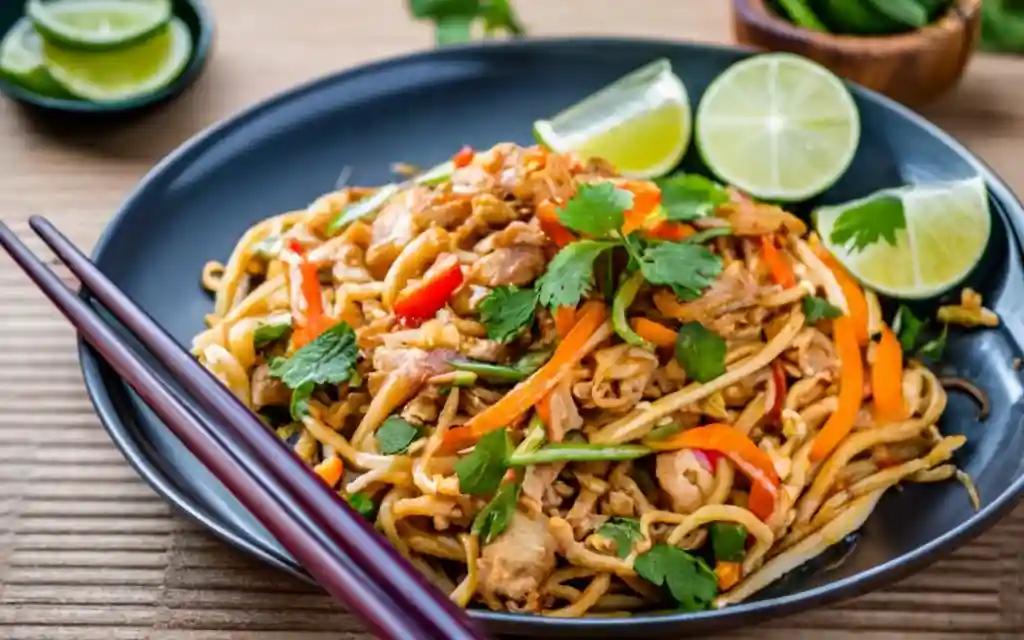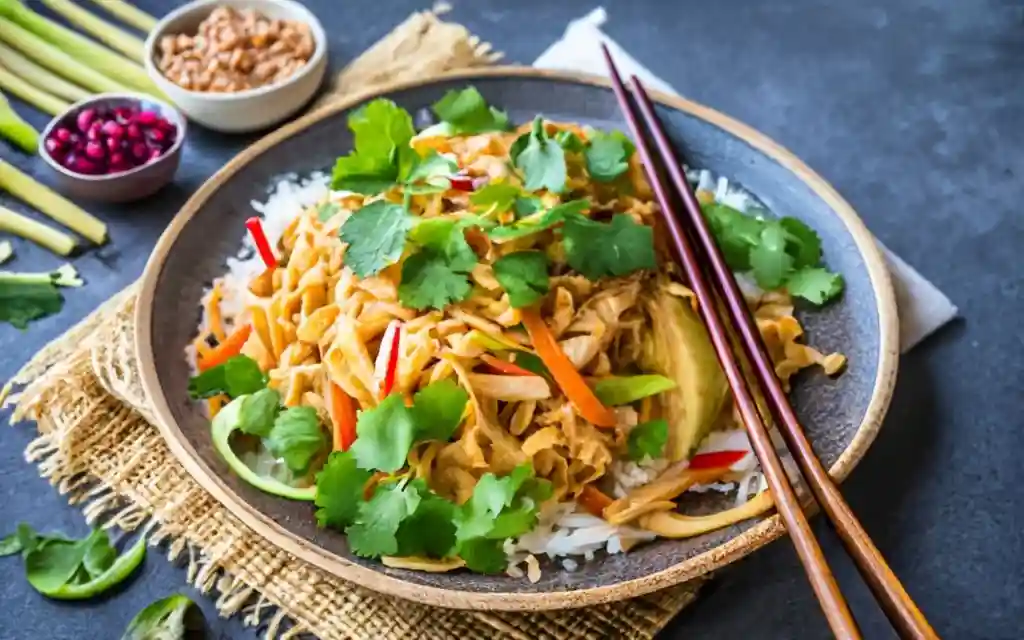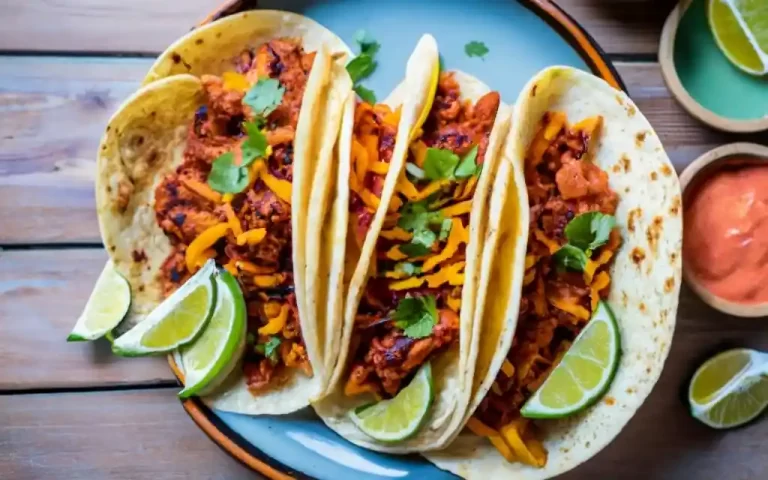How to Make Authentic Pad Thai

Pad Thai is a popular Thai dish that consists of stir-fried rice noodles, vegetables, protein (such as shrimp, chicken, or tofu), and a sweet and savoury sauce. It is typically served with lime wedges, chopped peanuts, and fresh herbs.
The origins of Pad Thai are somewhat unclear, but it is believed to have been invented in the mid-20th century as part of a campaign by the Thai government to promote a sense of national identity and encourage the consumption of rice noodles. The dish is thought to have been influenced by Chinese and Vietnamese noodle dishes and may have originally included ingredients like pickled radishes and dried shrimp.
Pad Thai has become one of the most well-known and widely enjoyed Thai dishes around the world, thanks in part to its appealing combination of sweet, salty, and sour flavours, as well as its accessibility and adaptability. The dish can be made with a variety of ingredients and can be tailored to suit different dietary needs, making it a favourite among both meat-eaters and vegetarians.
The basic components of Pad Thai include rice noodles, vegetables (such as bean sprouts, scallions, and carrots), protein (such as shrimp, chicken, or tofu), eggs, a sauce made from tamarind paste, fish sauce, and palm sugar, and garnishes like lime wedges and chopped peanuts. The dish is typically cooked in a wok or large skillet, with the noodles and vegetables stir-fried together before the protein and eggs are added and everything is tossed together with the sauce.
Ingredients
To make a classic Pad Thai dish, the following ingredients are typically needed
- Rice noodles
- Vegetable oil
- Garlic
- Shallots
- Tofu (or other protein such as shrimp or chicken)
- Eggs
- Bean sprouts
- Green onions
- Lime wedges
- Peanuts
- Cilantro
- Pad Thai sauce (made with tamarind paste, fish sauce, sugar, and chilli flakes)
Explanation of the role each ingredient plays in the recipe:
- Rice noodles: Rice noodles are the base of the Pad Thai dish. They are usually soaked in water before being stir-fried in the dish.
- Vegetable oil: Used to cook the dish.
- Garlic: Adds flavour to the dish.
- Shallots: Adds a sweet, subtle flavour to the dish.
- Tofu: Provides protein and texture to the dish. Other proteins like shrimp or chicken can also be used.
- Eggs: Adds protein and texture to the dish.
- Bean sprouts: Adds crunch and freshness to the dish.
- Green onions: Adds a slightly sweet onion flavour and texture to the dish.
- Lime wedges: Served as a garnish and adds tangy flavour to the dish.
- Peanuts: Adds crunch and nutty flavour to the dish.
- Cilantro: Served as a garnish and adds freshness and fragrance to the dish.
- Pad Thai sauce: The sauce is a blend of tamarind paste, fish sauce, sugar, and chilli flakes, and provides the signature tangy, sweet, and savoury flavours of the dish.
Preparation
Steps for making Pad Thai from scratch:
- Soak rice noodles in cold water for about 1 hour or until softened. Drain and set aside.
- Over high heat, heat a wok or large skillet. Add oil and swirl to coat.
- Add garlic and shallots and stir-fry for 1 minute until fragrant.
- Add protein of choice (chicken, shrimp, or tofu) and stir-fry until cooked through.
- Push protein to the side of the wok and crack in the egg. Scramble until cooked through.
- Add softened noodles and stir-fry for 1-2 minutes until the noodles are hot.
- Add Pad Thai sauce and stir-fry for 1-2 minutes until everything is well coated.
- Add bean sprouts and chives and stir-fry for 30 seconds.
- Remove from heat and garnish with crushed peanuts, lime wedges, and cilantro.
Tips for getting the perfect texture and flavour of Pad Thai:
- Use high-quality ingredients, especially for the sauce.
- Soak the rice noodles properly to achieve the right texture.
- Don’t overcook the noodles or they will become mushy.
- Adjust the sweetness, saltiness, and sourness of the Pad Thai sauce to your liking.
- Use a wok or large skillet to ensure that all ingredients are evenly cooked.
- Cook the protein first to ensure it is fully cooked and doesn’t dry out.
- Use fresh bean sprouts and chives for a crisp texture and fresh flavour.
- Garnish with crushed peanuts, lime wedges, and cilantro for added texture and flavour.
Suggestions for variations of the recipe:
- Vegetarian Pad Thai: Substitute tofu or vegetables (such as mushrooms, carrots, and bell peppers) for protein.
- Seafood Pad Thai: Use shrimp or a combination of shrimp and squid or scallops for the protein.
- Pad See Ew: Similar to Pad Thai but uses wide rice noodles and dark soy sauce instead of tamarind sauce.
- Pad Kee Mao (Drunken Noodles): Spicier version of Pad Thai that uses wide rice noodles and holy basil.
- Pad Thai Curry: Add Thai green or red curry paste to the stir-fry for a spicy twist on the classic recipe.
Serving and Presentation

After you have prepared your Pad Thai, it’s important to present it in an appetizing way. Here are some tips for serving and presenting Pad Thai:
- Choose the right plate: Traditionally, Pad Thai is served on a round plate, but you can use any plate you like. Just make sure it’s big enough to hold the noodles and toppings.
- Add garnishes: To make your Pad Thai look more appealing, add some garnishes. Common garnishes include chopped peanuts, cilantro, lime wedges, and bean sprouts. You can also add some sliced red chilli peppers for some extra spice.
- Arrange the noodles: Place the noodles in the centre of the plate and use a fork to arrange them into a neat pile.
- Add the toppings: Spoon the cooked vegetables, meat or shrimp, and scrambled egg over the top of the noodles.
- Drizzle the sauce: Drizzle the Pad Thai sauce over the top of the noodles and toppings, making sure to cover everything evenly.
To complete your meal, you may want to consider adding some side dishes and beverages that complement the flavours of Pad Thai. Here are some suggestions:
- Thai iced tea: This sweet and creamy tea is a popular beverage in Thailand and is the perfect complement to the spicy flavours of Pad Thai.
- Spring rolls: These fresh and crunchy rolls are made with rice paper and filled with vegetables, shrimp, and noodles. They are ideal as an appetiser or side dish.
- Mango salad: This light and refreshing salad is made with fresh mango, lettuce, cucumber, and red onion, and is dressed with a sweet and tangy dressing.
- Sticky rice: This sweet and glutinous rice is a staple in Thai cuisine and makes a great side dish for Pad Thai.
- Tom yum soup: This spicy and sour soup is made with lemongrass, lime juice, and chilli peppers, and is a popular soup in Thailand. It makes a great complement to the flavours of Pad Thai.
Nutritional Information and Dietary Considerations
Pad Thai is a flavorful and filling dish that is enjoyed by many people all around the world. The nutritional content of Pad Thai varies depending on the specific recipe and ingredients used. However, in general, Pad Thai contains a balance of carbohydrates, protein, and fat. The main source of carbohydrates in Pad Thai comes from rice noodles, while the protein comes from the meat or tofu used in the recipe. The peanuts and oil used in the recipe provide a source of healthy fats.
If you are looking to make Pad Thai healthier or more suitable for your dietary needs, there are several modifications you can make to the recipe. Here are some suggestions:
- Use brown rice noodles instead of white rice noodles. Brown rice noodles have more fibre and nutrients than white rice noodles.
- Use a lean protein source, such as chicken breast or shrimp, instead of fatty meats like pork or beef.
- Increase the number of vegetables in the recipe, such as bean sprouts, carrots, and bell peppers, to add more nutrients and fibre.
- Use less oil in the stir-fry, or use a healthy oil such as olive or avocado oil.
- For vegetarian or vegan diets, substitute the meat with tofu or tempeh, or use a vegetable-based protein source like edamame.
- If you have a gluten intolerance or allergy, use gluten-free rice noodles.
- Adjust the spiciness level to your liking. If you prefer a milder dish, use less chilli paste or omit it altogether.
By making these modifications, you can make Pad Thai a healthier and more nutritious dish that meets your dietary needs.
Storage and Reheating
Pad Thai can be refrigerated in an airtight container for up to three days. To store, let the Pad Thai cool down to room temperature and then place it in the container. Make sure to press the lid tightly to prevent air from getting in, as this can cause the noodles to dry out and become hard.
If you want to store Pad Thai for longer, you can freeze it for up to two months. To freeze, let the Pad Thai cool down completely and then transfer it to a freezer-safe container or bag. Again, press the lid tightly or seal the bag properly to prevent freezer burn.
To reheat Pad Thai, there are a few different methods you can use:
- Microwave: Place the Pad Thai in a microwave-safe dish and heat on high for 1-2 minutes, stirring every 30 seconds, until heated through.
- Stovetop: Heat a small amount of oil in a skillet over medium heat. Add the Pad Thai and stir-fry for a few minutes, until heated through.
- Oven: Preheat the oven to 350°F (175°C). Place the Pad Thai in an oven-safe dish and cover it with foil. Bake for 10-15 minutes, or until thoroughly heated.
No matter which method you choose, it’s important to make sure the Pad Thai is heated all the way through before serving.
Conclusion
In summary, Pad Thai is a popular and flavorful Thai dish that typically consists of stir-fried rice noodles, eggs, vegetables, and a protein such as shrimp or chicken, all mixed together with a tangy tamarind-based sauce. The dish originated in Thailand in the mid-20th century and has since gained worldwide popularity for its unique flavour and texture.
Making Pad Thai at home can be a fun and rewarding experience, as you can experiment with different ingredients and adjust the flavours to your liking. Some tips for making the perfect Pad Thai include using fresh and high-quality ingredients, properly soaking the noodles to achieve the desired texture, and adjusting the amount of spice and sweetness in the sauce to your taste.
You can also try different variations of the recipe, such as substituting the protein with tofu or adding different vegetables like bean sprouts or bell peppers. Additionally, you can make Pad Thai healthier by using less oil or adding more vegetables, and more suitable for different dietary needs by using gluten-free or vegan ingredients.
We hope you found this guide to making Pad Thai helpful and informative. If you have any comments, questions, or feedback on the recipe or any of the tips provided, please feel free to reach out to us. We would love to hear from you and help you make the best Pad Thai possible.
Pad Thai FAQs
Is Pad Thai spicy?
Pad Thai can be spicy, but the level of spice can be adjusted to personal preference. The dish typically includes chilli flakes or chilli paste, but these can be omitted or reduced if you prefer a milder flavour.
Can Pad Thai be made vegetarian or vegan?
Yes, Pad Thai can be made vegetarian or vegan by omitting meat or seafood and using tofu or vegetables instead. The sauce can also be made vegan by using a plant-based fish sauce alternative.
How do you make Pad Thai sauce from scratch?
To make Pad Thai sauce from scratch, you will need tamarind paste, fish sauce, soy sauce, brown sugar, and chilli flakes or chilli paste. Mix all the ingredients in a small bowl until well combined.
Can Pad Thai be made ahead of time?
Yes, Pad Thai can be made ahead of time and stored in the fridge for up to 3 days. To reheat, simply stir-fry the noodles and toppings in a wok or skillet until heated through.
What are some good side dishes to serve with Pad Thai?
Some good side dishes to serve with Pad Thai include fresh spring rolls, Thai fried rice, or a simple cucumber salad.
Can Pad Thai be frozen?
Yes, Pad Thai can be frozen for up to 2 months. To freeze, transfer the noodles to an airtight container and store them in the freezer. To reheat, thaw the noodles in the fridge overnight and then stir-fry in a wok or skillet.
What is the difference between Pad Thai and Pad See Ew?
Pad Thai and Pad See Ew are both popular Thai noodle dishes, but they have some key differences. Pad Thai is made with thin rice noodles, while Pad See Ew uses wider, flat rice noodles. Pad See Ew is also typically stir-fried with dark soy sauce and vegetables, while Pad Thai includes tamarind and peanuts in the sauce.
Is Pad Thai gluten-free?
Pad Thai can be made gluten-free by using gluten-free rice noodles and soy sauce. However, traditional Pad Thai sauce contains fish sauce, which may contain traces of gluten.
What is the best way to cook Pad Thai noodles?
The best way to cook Pad Thai noodles is to soak them in warm water for 30 minutes before stir-frying. This will soften the noodles and make them easier to cook evenly. It's also important to stir-fry the noodles quickly over high heat to prevent them from sticking together.






